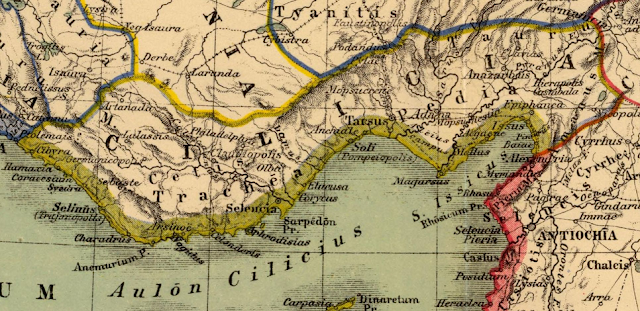Cilicia

Neolithic to Neo-Assyrian period[edit]
Cilicia was settled from the Neolithic period onwards. Dating of the ancient settlements of the region from Neolithic to Bronze Age is as follows: Aceramic/Neolithic: 8th and 7th millennia BC; Early Chalcolithic: 5800 BC; Middle Chalcolithic (correlated with Halaf and Ubaid developments in the east): c. 5400–4500 BC; Late Chalcolithic: 4500–c. 3400 BC; and Early Bronze Age IA: 3400–3000 BC; EBA IB: 3000–2700 BC; EBA II: 2700–2400 BC; EBA III A-B: 2400–2000 BC.[28]: 168–170
Probable captives from Cilicia, on the Nasiriyah stele of Naram-Sin, circa 2200 BC. The area had been known as Kizzuwatna in the earlier Hittite era (2nd millennium BC).[30][31] The region was divided into two parts, Uru Adaniya (flat Cilicia), a well-watered plain, and "rough" Cilicia (Tarza), in the mountainous west. Fugitive slave treaty between Idrimi of Alalakh (now Tell Atchana) and Pillia of Kizzuwatna (now Cilicia), (c. 1480 BC) Ref:131447.
The Cilicians appear as Hilikku in Assyrian inscriptions, and in the early part of the first millennium BC was one of the four chief powers of Western Asia. Homer mentions the plain as the "Aleian plain" in which Bellerophon wandered, but he transferred the Cilicians far to the west and north and made them allies of Troy. The Cilician cities unknown to Homer already bore their pre-Greek names: Tarzu (Tarsus), Ingira (Anchiale), Danuna-Adana, which retains its ancient name, Pahri (perhaps Mopsuestia), Kundu (Kyinda, then Anazarbus) and Azatiwataya (today's Karatepe).
There exists evidence that circa 1650 BC both Hittite kings Hattusili I and Mursili I enjoyed the freedom of movement along the Pyramus River (now the Ceyhan River in southern Turkey), proving they exerted strong control over Cilicia in their battles with Syria. After the death of Murshili around 1595 BC, Hurrians wrested control from the Hitties, and Cilicia was free for two centuries. The first king of free Cilicia, Išputahšu, son of Pariyawatri, was recorded as a "great king" in both cuneiform and Hittite hieroglyphs. Another record of Hittite origins, a treaty between Išputahšu and Telipinu, king of the Hittites, is recorded in both Hittite and Akkadian.
In the next century, the Cilician king Pilliya finalized treaties with both King Zidanta II of the Hittites and Idrimi of Alalakh, in which Idrimi mentions that he had assaulted several military targets throughout Eastern Cilicia. Niqmepa, who succeeded Idrimi as king of Alalakh, went so far as to ask for help from a Hurrian rival, Shaushtatar of Mitanni, to try and reduce Cilicia's power in the region. It was soon apparent, however, that increased Hittite power would soon prove Niqmepa's efforts to be futile, as the city of Kizzuwatna soon fell to the Hittites, threatening all of Cilicia. Soon after, King Sunassura II was forced to accept vassalization under the Hittites, becoming the last king of ancient Cilicia.[35] After the death of Mursili I, which led to a power struggle among rival claimants to the throne, eventually leading to the collapse of Hittite supremacy, Cilicia appeared to have regained its independence.
In the 13th century BC a major population shift occurred as the Sea Peoples overran Cilicia.[citation needed] The Hurrians that resided there deserted the area and moved northeast towards the Taurus Mountains, where they settled in the area of Cappadocia.[36] In the 8th century BC, the region was unified under the rule of the dynasty of Mukšuš, whom the Greeks rendered Mopsos[8] and credited as the founder of Mopsuestia,[10] though the capital was Adana. Mopsuestia's multicultural character is reflected in the bilingual inscriptions of the ninth and eighth centuries, written both in Indo-European hieroglyphic Luwian and West Semitic Phoenician. In the ninth century BC, it became part of Assyria and remained so until the late seventh century BC.
Main article: Kingdom of Cilicia (ancient)
Before the early foundings of the kingdom, Cilicians had to protect themselves from Assyrian domination. After the dissolution of the Neo-Assyrian Empire in 612 BC, they established an independent kingdom from Syria. Given the fact that Cilicia was a strategically significant location, Cilicians were able to expand their kingdom as far north as the Halys River in a short period of time. With these expansions, the Cilician Kingdom became as strong as Babylonia, one of the contemporary powerhouses. The Syennesis dynasty emerged in Cilicia and seemed to have been based in its western part during the reign of Appuašu. The peaceful governance of the Syennesis dynasty sustained the kingdom and prevented the Achaemenid Empire from attacking Lydians after the Achaemenid invasions of Median lands. Appuašu, the son of Syennesis, defended the country against the Babylonian king Neriglissar, whose army reached Cilicia and crossed the Taurus mountain range. The Achaemenids defeated the Lydians, and Appuašu had to recognize the authority of the Persians in 549 BC to keep the local administration with the Cilicians. Cilicia became an autonomous satrapy under the reign of Cyrus II.[38] Cilicians were independent in their internal affairs and kept this autonomy for almost 150 years. In 401, Syennesis III and his wife Epyaxa supported the revolt of Cyrus the Younger against his brother Artaxerxes II Mnemon. This was sound policy, because otherwise, Cilicia would have been looted by the rebel army. However, after the defeat of Cyrus at Cunaxa, keeping Syennesis' position was difficult. Most scholars assume that this behavior marked the end of the independence of Cilicia. After 400, it became a normal satrapy.




